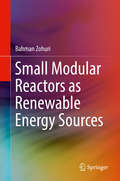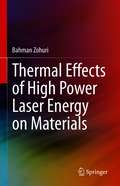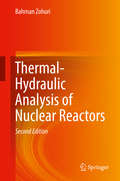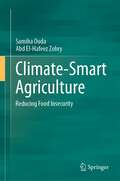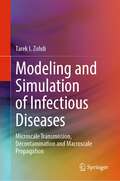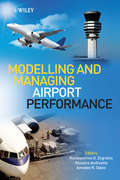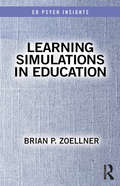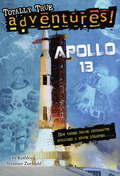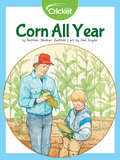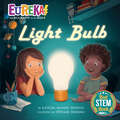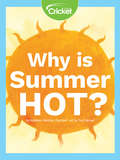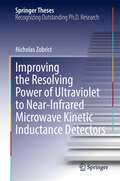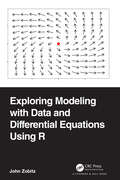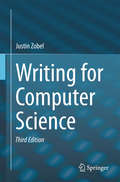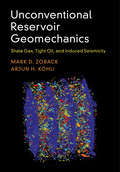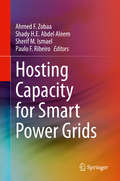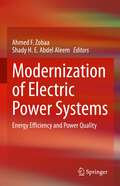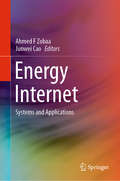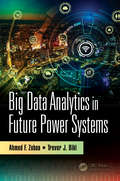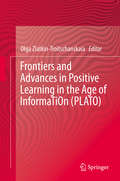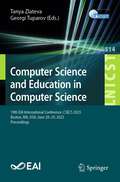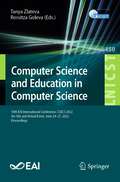- Table View
- List View
Small Modular Reactors as Renewable Energy Sources
by Bahman ZohuriThis book highlights Small Modular Reactors (SMRs) as a viable alternative to the Nuclear Power Plants (NPPs), which have been used as desalination plant energy sources. SMRs have lower investment costs, inherent safety features, and increased availability compared to NPPs. The unique and innovative approach to implementation of SMRs as part of Gen-IV technology outlined in this book contributes to the application of nuclear power as a supplementary source to renewable energy. Discusses Gen-IV Power plants, their efficiency, cost effectiveness, safety, and methods to supply renewable energy;Presents Small Modular Reactors as a viable alternative to Nuclear Power Plants;Describes the benefits, uses, safety features, and challenges related to implementation of Small Modular Reactors.
Thermal Effects of High Power Laser Energy on Materials
by Bahman ZohuriThis book offers a tutorial on the response of materials to lasers, with an emphasis on simple, intuitive models with analytical and mathematical solutions, using techniques such as Laplace Transformation to solve most complex heat conduction equations. It examines the relationship between existing thermal parameters of simple metals and looks at the characteristics of materials and their properties in order to investigate and perform theoretical analysis from a heat conduction perspective mathematically. Topics discussed include optical reflectivity of metals at infrared (IR) wavelengths, laser-induced heat flow in materials, the effects of melting and vaporization, the impulse generated in materials by pulsed radiation, and the influence of the absorption in the blow-off region in irradiated material. Written for engineers, scientists, and graduate-level engineering and physics students, Thermal Effects of High Power Laser Energy on Materials provides an in-depth look at high energy laser technology and its potential industrial and commercial applications in such areas as precision cutting, LIDAR and LADAR, and communications. The knowledge gained from this allows you to apply spaced-based relay mirror in order to compensate laser beam divergence back to its original coherency by preventing further thermal blooming that takes place during laser beam propagation through the atmosphere.Examines the state-of-the-art in currently available high energy laser technologies;Includes computer codes that deal with the response of materials to laser radiation;Provides detailed mathematical solutions of thermal response to laser radiation.
Thermal-Hydraulic Analysis of Nuclear Reactors
by Bahman ZohuriThis text covers the fundamentals of thermodynamics required to understand electrical power generation systems and the application of these principles to nuclear reactor power plant systems. It is not a traditional general thermodynamics text, per se, but a practical thermodynamics volume intended to explain the fundamentals and apply them to the challenges facing actual nuclear power plants systems, where thermal hydraulics comes to play. Written in a lucid, straight-forward style while retaining scientific rigor, the content is accessible to upper division undergraduate students and aimed at practicing engineers in nuclear power facilities and engineering scientists and technicians in industry, academic research groups, and national laboratories. The book is also a valuable resource for students and faculty in various engineering programs concerned with nuclear reactors. This book also: Provides extensive coverage of thermal hydraulics with thermodynamics in nuclear reactors, beginning with fundamental definitions of units and dimensions, thermodynamic variables, and the Laws of Thermodynamics progressing to sections on specific applications of the Brayton and Rankine cycles for power generation and projected reactor systems design issues Reinforces fundamentals of fluid dynamics and heat transfer; thermal and hydraulic analysis of nuclear reactors, two-phase flow and boiling, compressible flow, stress analysis, and energy conversion methods Includes detailed appendices that cover metric and English system units and conversions, detailed steam and gas tables, heat transfer properties, and nuclear reactor system descriptions
Climate-Smart Agriculture: Reducing Food Insecurity
by Abd El-Hafeez Zohry Samiha OudaThis book tackles the main feature of water-smart, soil-smart and crop-smart practices and their integration to sustainably enhance food production. The book includes some insights on the implications of using climate-smart practices in irrigated and rain-fed agriculture, and suggests approaches to eradicate the negative effects of water scarcity, climate variability and climate change. The book reviews the most important crops resilient to climate variability and their resistance to other biotic and abiotic stresses, and contains the existing practices in Egypt that achieved the three pillars of climate-smart agriculture
Modeling and Simulation of Infectious Diseases: Microscale Transmission, Decontamination and Macroscale Propagation
by Tarek I. ZohdiThe COVID-19 pandemic that started in 2019-2020 has led to a gigantic increase in modeling and simulation of infectious diseases. There are numerous topics associated with this epoch-changing event, such as (a) disease propagation, (b) transmission, (c) decontamination, and (d) vaccines. This is an evolving field. The targeted objective of this book is to expose researchers to key topics in this area, in a very concise manner. The topics selected for discussion have evolved with the progression of the pandemic. Beyond the introductory chapter on basic mathematics, optimization, and machine learning, the book covers four themes in modeling and simulation infectious diseases, specifically: Part 1: Macroscale disease propagation, Part 2: Microscale disease transmission and ventilation system design, Part 3: Ultraviolet viral decontamination, and Part 4: Vaccine design and immune response. It is important to emphasize that the rapid speed at which the simulations operate makes the presented computational tools easily deployable as digital twins, i.e., digital replicas of complex systems that can be inexpensively and safely optimized in a virtual setting and then used in the physical world afterward, thus reducing the costs of experiments and also accelerating development of new technologies.
Modelling and Managing Airport Performance
by Konstantinos Zografos Giovanni Andreatta Amedeo OdoniModelling and Managing Airport Performance provides an integrated view of state-of-the-art research on measuring and improving the performance of airport systems with consideration of both airside and landside operations. The considered facets of performance include capacity, delays, economic costs, noise, emissions and safety. Several of the contributions also examine policies for managing congestion and allocating sparse capacity, as well as for mitigating the externalities of noise, emissions, and safety/risk.Key features:Provides a global perspective with contributing authors from Europe, North and South America with backgrounds in academia, research institutions, government, and industryContributes to the definition, interpretation, and shared understanding of airport performance measures and related conceptsConsiders a broad range of measures that quantify operational and environmental performance, as well as safety and riskDiscusses concepts and strategies for dealing with the management of airport performancePresents state-of-the-art modelling capabilities and identifies future modelling needsThemed around 3 sections - Modelling Airport Performance, Assessing Airport Impacts, and Managing Airport Performance and Congestion Modelling and Managing Airport Performance is a valuable reference for researchers and practitioners in the global air transportation community.
Learning Simulations in Education (Ed Psych Insights)
by Brian P. ZoellnerTechnology-enabled simulations are increasingly used for students in K-12 education and have the potential to improve teaching and learning across domains. Across five chapters, this book explores the psychological foundation of simulation use in instruction, guiding readers through individual differences among learners and contexts while addressing theory, pedagogy, cognitive processes, and more. This concise volume is designed for any education course that includes simulations in the curriculum and will be indispensable for student researchers and both pre- and in-service teachers alike.
Apollo 13 (Totally True Adventures)
by Kathleen Weidner Zoehfeld Wesley LoweCould you survive an outer-space disaster? Aspiring astronauts and young explorers will love this out-of-this-world Totally True Adventure. Astronauts Jim Lovell, Jack Swigert, and Fred Haise blasted off for the Moon on April 11, 1970. But after a disastrous explosion damaged their spacecraft, the three men had only one goal: to get back home safely. This informational text makes space travel exciting and accessible for younger readers and features illustrations, photographs, a map, and additional Story Behind the Story facts. Perfect for readers of the I Survived series and the Who Was series, Totally True Adventures are captivating nonfiction stories with not-to-be-missed bonus content.
Corn All Year
by Kathleen Weidner ZoehfeldSpringtime means it's time to plant corn in the fields again. In September, it's ready to harvest.
Light Bulb: Eureka! The Biography of an Idea (Eureka! The Biography of an Idea)
by Kathleen Weidner ZoehfeldElectric lights--without them, we'd be in the dark! Here is a "biography" of the light bulb, an essential invention that lights up our days and nights.From the first spark of Thomas Alva Edison's idea to the spread of electric lights around the world, Light Bulb is a fun and informative look at an invention that makes a huge difference in our lives. This STEAM nonfiction title is part of the new Eureka! series, each book covering one groundbreaking, world-changing discovery that millions of people use every single day.
Phones Keep Us Connected (Let's-Read-and-Find-Out Science 2)
by Kathleen Weidner ZoehfeldRead and find out about the science, technology, and history of how phones work in this colorfully illustrated nonfiction picture book."A well-explained, informative presentation on the telephone’s historical development as well as how cell phones work. Featuring a diverse crew of characters, the upbeat digital illustrations are attractive and, equally important, very helpful in showing hard-to-visualize concepts." (Booklist starred review)Phones Keep Us Connected includes a glossary, a find out more section with an activity about building a string telephone, and an infographic about the history of the phone.Questions addressed in this book include:How was the phone invented?How has it changed?How can a phone carry your voice across oceans?Read and find out in the proven winner Phones Keep Us Connected!This is a Level 2 Let's-Read-and-Find-Out, which means the book explores more challenging concepts for children in the primary grades. The 100+ titles in this leading nonfiction series are:hands-on and visualacclaimed and trustedgreat for classroomsTop 10 reasons to love LRFOs:Entertain and educate at the same timeHave appealing, child-centered topicsDevelopmentally appropriate for emerging readersFocused; answering questions instead of using survey approachEmploy engaging picture book quality illustrationsUse simple charts and graphics to improve visual literacy skillsFeature hands-on activities to engage young scientistsMeet national science education standardsWritten/illustrated by award-winning authors/illustrators & vetted by an expert in the fieldOver 130 titles in print, meeting a wide range of kids' scientific interestsBooks in this series support the Common Core Learning Standards, Next Generation Science Standards, and the Science, Technology, Engineering, and Math (STEM) standards. Let's-Read-and-Find-Out is the winner of the American Association for the Advancement of Science/Subaru Science Books & Films Prize for Outstanding Science Series.
Secrets Of The Garden: Food Chains And The Food Web In Our Backyard
by Kathleen Weidner ZoehfeldPerfect for spring planting season--an outstanding book about backyard science the whole family will appreciate. <P><P> Alice's family plants a vegetable garden each spring, and this budding naturalist reports all she sees about how the plants grow, what insects come to eat the plants, and what birds and animals come to eat the insects It's the food chain, right in her own backyard! While Alice's narrative is simple and engaging, science concepts are presented in more depth in sidebars by a pair of very knowledgeable (and highly amusing) chickens! Noted science writer Kathleen Weidner Zoehfeld knows how to layer information to make it accessible to a wide range of readers and useful for educators. And illustrator Priscilla Lamont's funny, friendly paintings make this a garden everyone will want to explore. Kids will eat up this wonderful book of backyard science--and perhaps they'll even be inspired to eat their vegetables! "A wonderfully informative and enjoyable journey through one family's backyard garden, from spring planting to fall harvest. . . . this is bound to spark some backyard explorations. " --Kirkus, Starred Review From the Hardcover edition.
Why Is Summer Hot?
by Kathleen Weidner ZoehfeldHave you ever wondered why the days are so long in the summer and short in the winter? Or why we have hot weather and colder weather? Read on to learn about how the Earth, how it spins around the Sun, and the seasons!
Improving the Resolving Power of Ultraviolet to Near-Infrared Microwave Kinetic Inductance Detectors (Springer Theses)
by Nicholas ZobristThis thesis represents a breakthrough in our understanding of the noise processes in Microwave Kinetic Inductance Detectors (MKIDs). While the detection of ultraviolet to near-infrared light is useful for a variety of applications from dark matter searches to biological imaging and astronomy, the performance of these detectors often limits the achievable science. The author’s work explains the limits on spectral resolution broadening, and uses this knowledge to more than double the world record spectral resolution for an MKID suitable for optical and near-IR astrophysics, with emphasis on developing detectors for exoplanet detection. The techniques developed have implication for phonon control in many different devices, particularly in limiting cosmic ray-induced decoherence in superconducting qubits. In addition, this thesis is highly accessible, with a thorough, pedagogical approach that will benefit generations of students in this area.
Exploring Modeling with Data and Differential Equations Using R
by John ZobitzExploring Modeling with Data and Differential Equations Using R provides a unique introduction to differential equations with applications to the biological and other natural sciences. Additionally, model parameterization and simulation of stochastic differential equations are explored, providing additional tools for model analysis and evaluation. This unified framework sits "at the intersection" of different mathematical subject areas, data science, statistics, and the natural sciences. The text throughout emphasizes data science workflows using the R statistical software program and the tidyverse constellation of packages. Only knowledge of calculus is needed; the text’s integrated framework is a stepping stone for further advanced study in mathematics or as a comprehensive introduction to modeling for quantitative natural scientists. The text will introduce you to: modeling with systems of differential equations and developing analytical, computational, and visual solution techniques. the R programming language, the tidyverse syntax, and developing data science workflows. qualitative techniques to analyze a system of differential equations. data assimilation techniques (simple linear regression, likelihood or cost functions, and Markov Chain, Monte Carlo Parameter Estimation) to parameterize models from data. simulating and evaluating outputs for stochastic differential equation models. An associated R package provides a framework for computation and visualization of results. It can be found here: https://cran.r-project.org/web/packages/demodelr/index.html.
Writing for Computer Science
by Justin ZobelAll researchers need to write or speak about their work, and to have research that is worth presenting. Based on the author's decades of experience as a researcher and advisor, this third edition provides detailed guidance on writing and presentations and a comprehensive introduction to research methods, the how-to of being a successful scientist. Topics include: · Development of ideas into research questions; · How to find, read, evaluate and referee other research; · Design and evaluation of experiments and appropriate use of statistics; · Ethics, the principles of science and examples of science gone wrong. Much of the book is a step-by-step guide to effective communication, with advice on: · Writing style and editing; · Figures, graphs and tables; · Mathematics and algorithms; · Literature reviews and referees' reports; · Structuring of arguments and results into papers and theses; · Writing of other professional documents; · Presentation of talks and posters. Written in an accessible style and including handy checklists and exercises, Writing for Computer Science is not only an introduction to the doing and describing of research, but is a valuable reference for working scientists in the computing and mathematical sciences.
Unconventional Reservoir Geomechanics: Shale Gas, Tight Oil, and Induced Seismicity
by Mark D. Zoback Arjun H. KohliSince the beginning of the US shale gas revolution in 2005, the development of unconventional oil and gas resources has gathered tremendous pace around the world. This book provides a comprehensive overview of the key geologic, geophysical, and engineering principles that govern the development of unconventional reservoirs. The book begins with a detailed characterization of unconventional reservoir rocks: their composition and microstructure, mechanical properties, and the processes controlling fault slip and fluid flow. A discussion of geomechanical principles follows, including the state of stress, pore pressure, and the importance of fractures and faults. After reviewing the fundamentals of horizontal drilling, multi-stage hydraulic fracturing, and stimulation of slip on pre-existing faults, the key factors impacting hydrocarbon production are explored. The final chapters cover environmental impacts and how to mitigate hazards associated with induced seismicity. This text provides an essential overview for students, researchers, and industry professionals interested in unconventional reservoirs.
Reservoir Geomechanics
by Mark D. ZobackA practical reference for geoscientists and engineers in the petroleum and geothermal industries.
Hosting Capacity for Smart Power Grids
by Ahmed F. Zobaa Shady H. E. Abdel Aleem Sherif M. Ismael Paulo F. RibeiroThis book brings together several aspects of hosting capacity (HC) assessment and enhancement of modern electrical power systems, HC is a key enabler for affordable, reliable and renewable energy sources, that will aid in transitioning away from traditional high-carbon energy sources. The chapters provide insight into the state of the art on current hosting capacity concepts, restrictive performance limits, distribution network operators and network planners’ viewpoints, and the cutting-edge technologies deployed worldwide for hosting capacity enhancement. Written by leading experts in power, control, and renewable energy resources. This book is beneficial to distribution system operators, network planners, distribution generation investors, and researchers in this field. Due to its broad scope, it is an ideal resource for students in advanced graduate-level courses and special topics in the field of hosting capacity assessment and enhancement in modern electrical power systems.
Modernization of Electric Power Systems: Energy Efficiency and Power Quality
by Ahmed F. Zobaa Shady H. E. Abdel AleemThis timely book examines the significant challenges and possible solutions for enabling efficient modernization of electric power systems. It addresses rapidly changing electricity infrastructure needs and technical requirements and provides a practical introduction to the past, present, and future of energy efficiency and power quality concepts. The book also looks at recent developments in custom power conditioners that help improve the performance of transmission and distribution systems, ensure reliability, and reduce costs. Modernization of Electric Power Systems is a valuable resource for practicing engineers, students, and researchers interested in exploring and implementing energy efficiency and power quality in modern energy systems with renewables.
Energy Internet: Systems and Applications
by Ahmed F Zobaa Junwei CaoThis textbook is the first of its kind to comprehensively describe the energy Internet, a vast network that efficiently supplies electricity to anyone anywhere and is an internet based wide area network for information and energy fusion. The chapters are organized into five parts: Architecture and Design, Energy Switching and Routing, Information and Communication, Energy Management Systems and Energy Market and Trading, and capture the spectrum of this exponential transformation, while also presenting the plethora of open problems that this transformation poses for researchers from mixed academic backgrounds. The scope includes key technologies on distributed energy sources, microgrids, energy storage, solar and wind energy, power grid, smart grid, power quality, power electronics, data centers, distributed computing and networking, cloud computing and big data, and software-defined networking. The book presents the basic principles of energy internet and emphasizes the current research trends in the field of energy Internet at an advanced level. It includes instructor materials, case-studies, and worked examples throughout. This is an ideal resource for students in advanced graduate-level courses and special topics in energy, information and control systems, and is a useful tool for utility engineers who seek an intuitive understanding of the emerging applications of energy Internet.
Big Data Analytics in Future Power Systems
by Ahmed F. Zobaa Trevor J. BihlPower systems are increasingly collecting large amounts of data due to the expansion of the Internet of Things into power grids. In a smart grids scenario, a huge number of intelligent devices will be connected with almost no human intervention characterizing a machine-to-machine scenario, which is one of the pillars of the Internet of Things. The book characterizes and evaluates how the emerging growth of data in communications networks applied to smart grids will impact the grid efficiency and reliability. Additionally, this book discusses the various security concerns that become manifest with Big Data and expanded communications in power grids. Provide a general description and definition of big data, which has been gaining significant attention in the research community. Introduces a comprehensive overview of big data optimization methods in power system. Reviews the communication devices used in critical infrastructure, especially power systems; security methods available to vet the identity of devices; and general security threats in CI networks. Presents applications in power systems, such as power flow and protection. Reviews electricity theft concerns and the wide variety of data-driven techniques and applications developed for electricity theft detection.
Frontiers and Advances in Positive Learning in the Age of InformaTiOn (PLATO)
by Olga Zlatkin-TroitschanskaiaResearch on students’ media use outside of education is just slowly taking off. Influences of information and communication technologies (ICT) on human information processing are widely assumed and particularly effects of dis- and misinformation are a current threat to democracies. Today, higher education competes with a very diverse (online) media landscape and domain-specific content from sources of varying quality, ranging from high-quality videographed lectures by top-level university lecturers, popular-scientific video talks, collaborative wikis, anonymous forum comments or blog posts to YouTube remixes of discipline factoids and unverified twitter feeds. Self-organizing learners need more knowledge, skills, and awareness on how to critically evaluate quality and select trustworthy sources, how to process information, and what cognitive, affective, attitudinal, behavioral, and neurological effects it can have on them in the long term. The PLATO program takes on the ambitious goal of uniting strands of research from various disciplines to address these questions through fundamental analyses of human information processing when learning with the Internet. This innovative interdisciplinary approach includes elements of ICT innovations and risks, learning analytics and large-scale computational modelling aimed to provide us with a better understanding of how to effectively and autonomously acquire reliable knowledge in the Information Age, how to design ICTs, and shape social and human-machine interactions for successful learning. This volume will be of interest to researchers in the fields of educational sciences, educational measurement and applied branches of the involved disciplines, including linguistics, mathematics, media studies, sociology of knowledge, philosophy of mind, business, ethics, and educational technology.
Computer Science and Education in Computer Science: 19th EAI International Conference, CSECS 2023, Boston, MA, USA, June 28–29, 2023, Proceedings (Lecture Notes of the Institute for Computer Sciences, Social Informatics and Telecommunications Engineering #514)
by Tanya Zlateva Georgi TuparovThis book constitutes the refereed post-conference proceedings of the 19th International Conference on Computer Science and Education in Computer Science, CSECS 2023, held in June 2023 in Boston, MA, USA.The 23 full papers and 9 short papers were carefully reviewed and selected from 88 submissions. The papers cover many systems technologies, applications, and services as well as solutions. Multiple topics have been addressed including the theory of computation, models of computation, computational complexity and cryptography, logic, design, and analysis of algorithms, network architectures, performance evaluation, network services, software engineering, software creation, and management, applied computing, machine learning, and education.
Computer Science and Education in Computer Science: 18th EAI International Conference, CSECS 2022, On-Site and Virtual Event, June 24-27, 2022, Proceedings (Lecture Notes of the Institute for Computer Sciences, Social Informatics and Telecommunications Engineering #450)
by Tanya Zlateva Rossitza GolevaThis book constitutes the refereed post-conference proceedings of the 18th EAI International Conference on Computer Science and Education in Computer Science, CSECS 2022, held in June 2022 in Sofia, Bulgaria. Due to COVID-19 pandemic the conference was held On-Site and virtually.The 15 full papers and 9 short papers were carefully reviewed and selected from 53 submissions. The papers present are grouped into 2 tracks, i.e., computer science implementations and education in computer science. CSECS conference presents research in software engineering and information systems design, cryptography, the theoretical foundation of the algorithms, and implementation of machine learning and big data technologies. Another important topic of the conference is the education in computer science which includes the introduction and evaluation of computing programs, curricula, and online courses, to syllabus, laboratories, teaching, and pedagogy aspects. The technical and education topics evolved multiple existing and emerging technologies, solutions, and services for design and training providing a heterogeneous approach towards delivering Software 4.0 and Education 4.0 to a broad range of citizens and societies.
